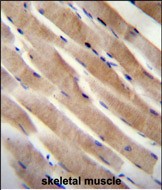RHEB Antibody (C-term)
Purified Rabbit Polyclonal Antibody (Pab)
- 产品详情
- 实验流程
- 背景知识
Application
| WB, IHC-P, E |
|---|---|
| Primary Accession | Q15382 |
| Other Accession | Q62639, Q921J2, Q56JV3, NP_005605.1 |
| Reactivity | Human |
| Predicted | Bovine, Mouse, Rat |
| Host | Rabbit |
| Clonality | Polyclonal |
| Isotype | Rabbit IgG |
| Calculated MW | 20497 Da |
| Antigen Region | 104-134 aa |
| Gene ID | 6009 |
|---|---|
| Other Names | GTP-binding protein Rheb, Ras homolog enriched in brain, RHEB, RHEB2 |
| Target/Specificity | This RHEB antibody is generated from rabbits immunized with a KLH conjugated synthetic peptide between 104-134 amino acids from the C-terminal region of human RHEB. |
| Dilution | WB~~1:1000 IHC-P~~1:100~500 E~~Use at an assay dependent concentration. |
| Format | Purified polyclonal antibody supplied in PBS with 0.09% (W/V) sodium azide. This antibody is prepared by Saturated Ammonium Sulfate (SAS) precipitation followed by dialysis against PBS. |
| Storage | Maintain refrigerated at 2-8°C for up to 2 weeks. For long term storage store at -20°C in small aliquots to prevent freeze-thaw cycles. |
| Precautions | RHEB Antibody (C-term) is for research use only and not for use in diagnostic or therapeutic procedures. |
| Name | RHEB {ECO:0000303|PubMed:8543055, ECO:0000312|HGNC:HGNC:10011} |
|---|---|
| Function | Small GTPase that acts as an allosteric activator of the canonical mTORC1 complex, an evolutionarily conserved central nutrient sensor that stimulates anabolic reactions and macromolecule biosynthesis to promote cellular biomass generation and growth (PubMed:12172553, PubMed:12271141, PubMed:12842888, PubMed:12869586, PubMed:12906785, PubMed:15340059, PubMed:15854902, PubMed:16098514, PubMed:20381137, PubMed:22819219, PubMed:24529379, PubMed:29416044, PubMed:32470140, PubMed:33157014, PubMed:25816988). In response to nutrients, growth factors or amino acids, specifically activates the protein kinase activity of MTOR, the catalytic component of the mTORC1 complex: acts by causing a conformational change that allows the alignment of residues in the active site of MTOR, thereby enhancing the phosphorylation of ribosomal protein S6 kinase (RPS6KB1 and RPS6KB2) and EIF4EBP1 (4E-BP1) (PubMed:29236692, PubMed:33157014). RHEB is also required for localization of the TSC-TBC complex to lysosomal membranes (PubMed:24529379). In response to starvation, RHEB is inactivated by the TSC-TBC complex, preventing activation of mTORC1 (PubMed:24529379, PubMed:33157014). Has low intrinsic GTPase activity (PubMed:15340059). |
| Cellular Location | Endomembrane system; Lipid-anchor; Cytoplasmic side. Lysosome membrane; Lipid-anchor; Cytoplasmic side. Golgi apparatus membrane; Lipid-anchor; Cytoplasmic side. Endoplasmic reticulum membrane; Lipid-anchor; Cytoplasmic side. Cytoplasm, cytosol. Note=Farnesylation is required for recruitment to lysosomal membranes, where it activates the mTORC1 complex. |
| Tissue Location | Ubiquitous (PubMed:8543055). Highest levels observed in skeletal and cardiac muscle (PubMed:8543055) |
For Research Use Only. Not For Use In Diagnostic Procedures.
Provided below are standard protocols that you may find useful for product applications.
BACKGROUND
This gene is a member of the small GTPase superfamily and encodes a lipid-anchored, cell membrane protein with five repeats of the RAS-related GTP-binding region. This protein is vital in regulation of growth and cell cycle progression due to its role in the insulin/TOR/S6K signaling pathway. The protein has GTPase activity and shuttles between a GDP-bound form and a GTP-bound form, and farnesylation of the protein is required for this activity. Three pseudogenes have been mapped, two on chromosome 10 and one on chromosome 22.
REFERENCES
Zheng, H., et al. Cancer Lett. 297(1):117-125(2010)
Kim, H.W., et al. Mol. Cell. Biol. 30(22):5406-5420(2010)
Karassek, S., et al. J. Biol. Chem. 285(44):33979-33991(2010)
Wagner, R.J., et al. Am. J. Physiol., Cell Physiol. 299 (1), C119-C127 (2010) :
Lu, Z.H., et al. Cancer Res. 70(8):3287-3298(2010)
终于等到您。ABCEPTA(百远生物)抗体产品。
点击下方“我要评价 ”按钮提交您的反馈信息,您的反馈和评价是我们最宝贵的财富之一,
我们将在1-3个工作日内处理您的反馈信息。
如有疑问,联系:0512-88856768 tech-china@abcepta.com.























 癌症的基本特征包括细胞增殖、血管生成、迁移、凋亡逃避机制和细胞永生等。找到癌症发生过程中这些通路的关键标记物和对应的抗体用于检测至关重要。
癌症的基本特征包括细胞增殖、血管生成、迁移、凋亡逃避机制和细胞永生等。找到癌症发生过程中这些通路的关键标记物和对应的抗体用于检测至关重要。 为您推荐一个泛素化位点预测神器——泛素化分析工具,可以为您的蛋白的泛素化位点作出预测和评分。
为您推荐一个泛素化位点预测神器——泛素化分析工具,可以为您的蛋白的泛素化位点作出预测和评分。 细胞自噬受体图形绘图工具为你的蛋白的细胞受体结合位点作出预测和评分,识别结合到自噬通路中的蛋白是非常重要的,便于让我们理解自噬在正常生理、病理过程中的作用,如发育、细胞分化、神经退化性疾病、压力条件下、感染和癌症。
细胞自噬受体图形绘图工具为你的蛋白的细胞受体结合位点作出预测和评分,识别结合到自噬通路中的蛋白是非常重要的,便于让我们理解自噬在正常生理、病理过程中的作用,如发育、细胞分化、神经退化性疾病、压力条件下、感染和癌症。







